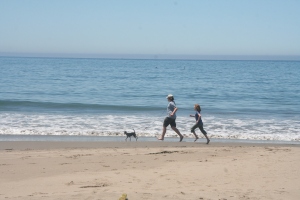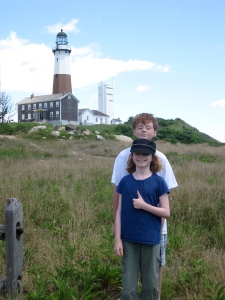This story was an ‘Editor’s Pick’ today on Open Salon. Open Salon: You make the headlines Or, here it is:
No One Told Me About the Rats
Sunny California. Palo Alto. Heart of the Silicon Valley. Short drive to San Francisco. Fabulous public schools. These are the sound bites I reel off to my new friends in East Hampton about our upcoming move. It has been a long winter for our family and I’m giddy with so many beautiful colors surrounding me – the bright yellow daffodils, the soft pink peonies and the pastel lilacs – and with the fact we’ve finally made a decision.
We hadn’t planned to spend so much time in East Hampton, just a couple of months to re-enter the United States after living in Australia for close to six years. Our friends offered their summer home for this purpose, a Disneyland with a heated pool, cupboards filled with supplies from BJ’s warehouse, seven TVs and a garage loaded with sporting equipment. ‘Don’t get used to this,’ we told our three children.
My husband, Tim spent that winter trying to figure out what to do with a newly minted PhD in machine learning from The Australian National University. ‘Machine what?’ his former colleagues he’d worked with for almost twenty years on Wall Street asked. ‘Why would you want to come back here?’ a friend at Goldman Sachs asked him. ‘You’ve re-tooled. You have the golden ticket!’ Yes, but to what Tim wondered as we watched the snow pile up on the driveway, which as punishment for our lack of direction we shoveled ourselves after each storm.
There were good times that winter. During school break I taught the kids how to ice skate. We also hiked in the mud on Shelter Island. Afterwards we warmed up inside the nature center and watched birds darting around feeders set up outside, teaching the kids the names of the North American species. On Saturday nights we became obsessed with Settlers of Catan, a board game similar to Risk but possible to complete in an evening. The kids’ personalities would emerge: Ian, our teenager is a quiet strategist, TJ our middle child likes to win and is not ashamed to admit it and Corinne, our youngest at age nine was delighted to be included. She teamed up with Tim and rolled the dice with expertise. I sipped on my goblet of red wine and thanked God the kids were ok, despite their parent’s temporary insanity. I even dared tell myself that perhaps we would remember this as a good time for the family, a bonding time. Still, the kids need more than family. They need to make friends who will be around for a while.
Throughout the winter, Tim spoke to contacts on Wall Street, but his heart wasn’t in it. What he really wanted to do was start his own company in the technology industry. He began to speak to entrepreneurs in Boston and the Silicon Valley. Along the way he met his future partner, Phil who was based in San Mateo, California. Together they hatched a plan to provide one-to-one marketing over smartphones. It was a good idea and the first spark I’d seen in Tim’s eyes in a while. However, it was unsettling for me. I knew Tim wouldn’t force a move, but I could tell he had found his direction. Hadn’t we already taken enough risk moving to Australia? Wasn’t it time to settle down with a proper job? Reconnecting with family and friends on familiar turf was comforting. I wasn’t sure I was ready for another leap of faith.
With the arrival of spring my risk-taking profile somehow changes. I start to wonder how all my fear made me forget the fact that it is Tim offering to go to work everyday. How could I dream of sending him to the caverns on Wall Street (remember, you worked there too Beth) if his heart isn’t in it? Maybe it’s the optimism of the birds laying fresh eggs or the crocuses giving it their all to push through the snowdrifts to add color to our bleak existence. Maybe it’s as simple as a phone call from Leo, an artist and member of my writing group urging me to come over and pick some lilacs from his tree before it’s too late. Not everyone is so lucky to have such caring friends. Come to think of it, Ashawagh Hall Writer’s Group turned out to be my saving grace this winter.
Each Thursday evening I climbed the stairs to an attic-like room with sporadic heat and difficult windows to listen and read to a dozen or so talented and nurturing writers seated around a long table. Led by the passsionate young adult author M.E. Kerr (aka Marijane Meeker) I had stumbled onto something special. When my first reading flopped I received several encouraging emails telling me to hang in there. After my third reading, when Marijane told me I was a ‘quick learner’ and that she had ‘no comment’ because my chapter was ‘just great’, I glowed.
When I’m engaged the future is less worrying. I’m more interested in having enough hours in the day to pursue my interests. What’s more, I married a man fully capable of taking care of himself, provided I let him. Instead, I interrogated, pressured and doubted. Here was a man who skipped high school to go straight to college. Perhaps he was onto something if I would simply give him the space to explore. He’s never let you down, Beth. Let him go.
‘I think we should move to California,’ I say to Tim over our oatmeal one morning. ‘We need to move forward.’
Even though this sounds like a snap decision, Tim knows I’ve thought it over carefully. He’d felt my wet pillow at times in the middle of the night. He’d watched me shrink away from a social life. He wasted no time sealing a deal with Phil.
After spending the winter moping, I make a conscious decision to become positive about this venture. Tim shouldn’t have to shoulder the worry by himself. Time to rejoin the team. The kids need to feel secure if we’re going to have a shot at a smooth transition. Once I frame our move in a positive light, it actually sounds like be a good idea. I try out my affirmative spin for a few days and it becomes contagious. Tim’s confidence grows. The kids decide it might be fun to move out West, despite the fact they’ll be leaving their beloved cousins behind.
By late May 2010 I fly to Palo Alto to find a house to rent. The market for a family home is tight and expensive. I settle on a renovated 70s ranch set in the hills just north of downtown Palo Alto on Robb Road. I like the alliterative sound of our street. I also like the garden filled with lemon, apricot and apple trees. It all feels California organic, but with plenty of convenient shops nearby.
‘California ranch with a hot tub!’ I tell my friends back in East Hampton, even though the place is a tad rundown and I doubt we’ll use the hot tub.
One afternoon during my visit out West, I drive over to Stanford Hospital to drop off a card for Phil. The previous week, Phil had fainted a couple of times while on a camping trip with his son. He had mentioned a nagging sinus infection to Tim more than once. After the fainting spells, Tim urged him to return to his doctor who in turn sent him to a neurologist who diagnosed a brain tumor. The hospital staff won’t give me details on Phil’s condition and I don’t want to bother his family, so I simply drop off the card and leave.
A week later, we receive a phone call telling us Phil has died. Apparently, his brain swelled after surgery and a second emergency operation didn’t save him. We’re stunned. We underestimated the seriousness of his condition. Phil was only 45 and left behind a wife and two small boys. How could he be here one month, skiing at Tahoe and then be gone so suddenly? His death was hard to comprehend. I couldn’t imagine how his wife felt.
Days later, Tim and I guiltily broach the question hovering in the air, ‘Now what?’ We decide to go ahead with our plan. It’s still a good business idea, we’ve already told the kids and we can’t stay in our friends’ summerhouse much longer, they’re returning from London in a matter of weeks. Tim will go it alone until he finds a new business partner. He can only hope to find a man as upstanding as Phil.
By early July Tim flies out West to begin work and to receive our two shipments of furniture: one from Australia, the other from a storage container in New Jersey. He will ‘camp out’ while he waits, sleeping on an air mattress and eating off paper plates. The kids and I will travel for a few weeks until the house can be settled.
Ian, TJ, Corinne and I spend a week with dear friends on Martha’s Vineyard, tour Boston with cousin Sheila, ride the Maid of the Mist at Niagra Falls and eventually land at my brother’s house in Chicago. Along the way we eat numerous ice cream cones and burgers and loll around reading books purchased at the beginning of our journey at one of our favorite bookstores in Madison, Connecticut. Although our travels have been fun, I’m ready to land at our permanent address, however humbly furnished. The kids are ready too. So supportive during our winter of discontent, they’ve found their voices again and they’re shouting, ‘We want to go home!’
Tim has other ideas. He tells me the house is a mess with unpacked boxes and that the kids will hate sleeping on air mattresses. I’m surprised (and a little hurt) that he isn’t more anxious to see us. This isn’t like him. We did have a tough winter I rationalize. Maybe he needs a little more time on his own. How was I to know that he had plenty company?
On Saturday, July 17th we begin the final leg of our journey to California and board a United flight from O’Hare to San Francisco. We just fit into Tim’s new Prius for the drive to our new house. As we drive up Robb Road TJ says, ‘Nice!’ pointing at the Georgian manor house behind a stately gate up the hill from our rental.
‘Oh, no TJ, we’re in that cute tan house nestled into the hill below.’ The one with the non-mechanized gate, I mutter, momentarily forgetting my positivity pact. We unpack the car and roll our duffel bags to the front entrance.
‘The front door looks kind of beat up,’ TJ says.
‘It’s a distressed, ranchy kind of look,’ I say. He looks doubtful. Ian glares at him as if to say, c’mon buddy, be a good sport. Once inside, I show TJ the downstairs, which we’ve designated a kids’ zone. TJ brightens up, especially when I remind him we have foosball and ping pong tables arriving soon. If only it were that easy to turn my own dark clouds into sunny skies. Soon I learn the front door is the least of my worries.
That evening we drive into Los Altos for Mexican. Seated outdoors, I sip on a large margarita while the kids devour chips and salsa. A mariachi band plays in the corner. ‘Happy?’ Tim asks.
‘Yup, it actually feels right to be here,’ I say. I’m surprised to find I actually mean it.
Back home, we all climb into the hot tub on the deck outside the master bedroom and watch the planes line up to land at the San Francisco airport against the backdrop of the San Andreas Fault.
A few nights later, after I’ve cooked eggs in our only frying pan, we sprawl out on the air mattresses in the living room. The kids are tired from playing tennis and swimming all day. I enrolled them at the local club to ensure they don’t have time to miss their friends.
‘Did you hear that?’ Tim asks.
‘What?’
‘That scratching noise,’ he says.
I pause to listen and do in fact hear a scratching noise. ‘That’s just the house settling. Remember, earthquakes are happening all the time out here.’
He nods, but doesn’t look convinced. By the time we go to bed he blurts, ‘We have rats.’ He feels me stiffen and runs on, ‘but the rat guy has been here and it should be taken care of.’ I guess he wasn’t alone after all.
Thoughts of scratchy feet pitter-pattering across my pillow and indeed, even the Plague flit through my mind.
‘It’s ok,’ I tell him. ‘We can deal with it.’
Read Full Post »
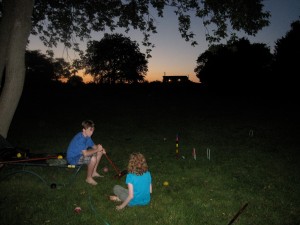 Baltimore Cousins visit California Cousins:
Baltimore Cousins visit California Cousins: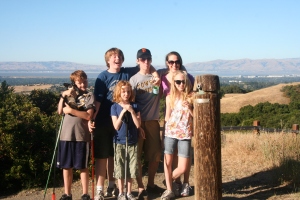
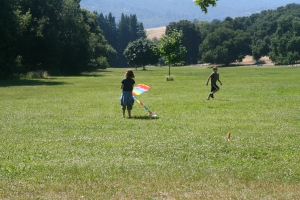 Running with four-legged friend on the beach:
Running with four-legged friend on the beach: